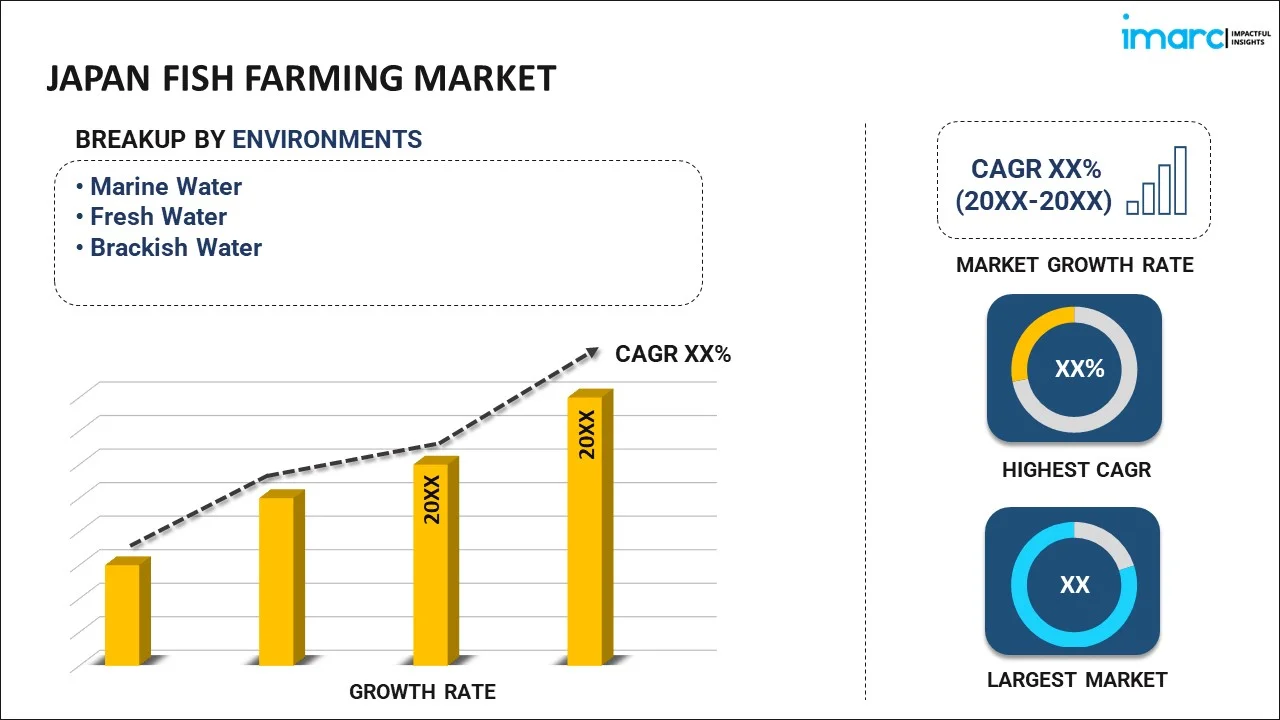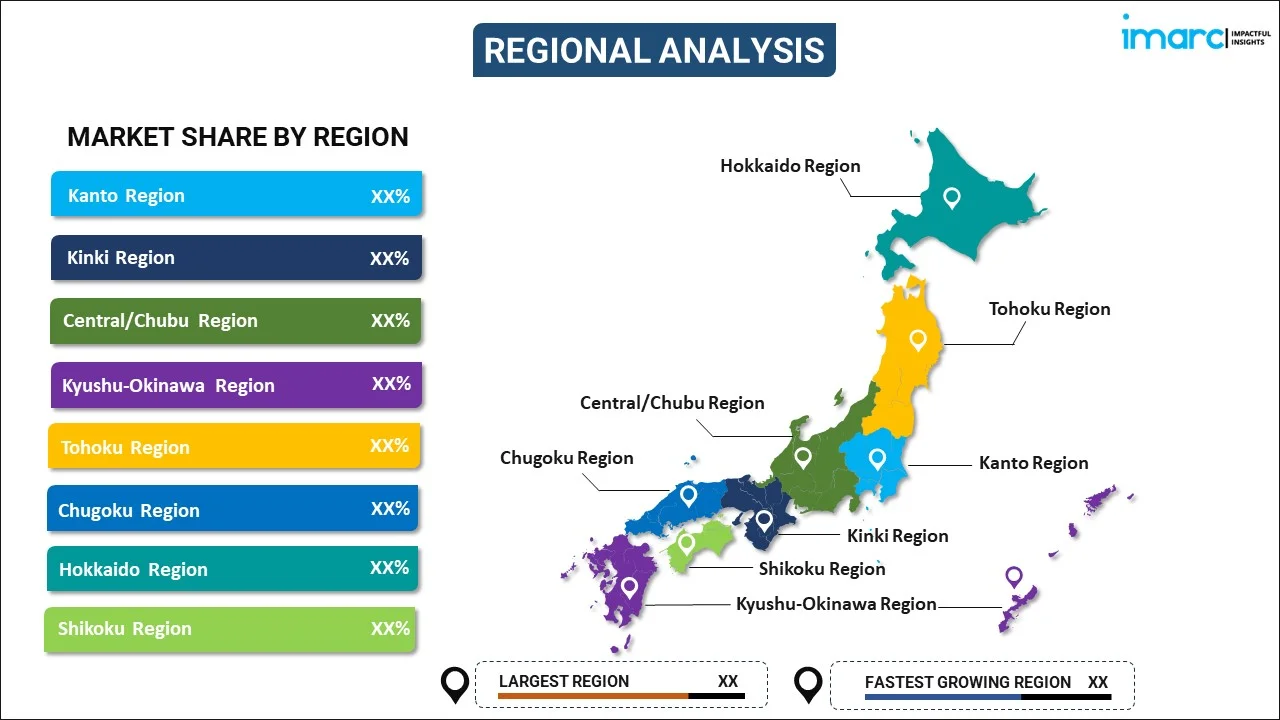
Japan Fish Farming Market Report by Environment (Marine Water, Fresh Water, Brackish Water), Fish Type (Salmon, Milkfish, Tuna, Tilapia, Catfish, Sea Bass, and Others), and Region 2025-2033
Market Overview:
The Japan fish farming market size reached USD 19,061 Million in 2024. Looking forward, IMARC Group expects the market to reach USD 27,478 Million by 2033, exhibiting a growth rate (CAGR) of 4.1% during 2025-2033.The increasing demand for seafood, rapid technological advancements, growing health awareness, rising popularity of Japanese cuisine, and increasing focus of environment sustainability represent some of the key factors driving the market.
|
Report Attribute
|
Key Statistics
|
|---|---|
|
Base Year
|
2024 |
|
Forecast Years
|
2025-2033
|
|
Historical Years
|
2019-2024
|
| Market Size in 2024 | USD 19,061 Million |
| Market Forecast in 2033 | USD 27,478 Million |
| Market Growth Rate (2025-2033) | 4.1% |
Fish farming, also known as aquaculture, is a specialized form of agriculture that involves the breeding and rearing of fish in controlled environments such as tanks, ponds, or enclosures. It provides a sustainable solution to meet the increasing demand for seafood and helps reduce pressure on wild fish populations. Fish farming produces a consistent and reliable supply of high-quality seafood, irrespective of seasonal variations and weather conditions. Fish farming also facilitates the cultivation of specific fish species in high demand, such as premium-grade salmon, bluefin tuna, and yellowtail, known for their exquisite taste and texture. It also helps reduce the need for intensive fishing in the wild and helps mitigate overfishing and its detrimental impact on marine biodiversity. Sustainable aquaculture practices can also be implemented to minimize waste production, recycle water, and adopt eco-friendly feed formulations, reducing the industry's ecological footprint and ensuring responsible resource management.
Japan Fish Farming Market Trends:
The rising demand for seafood and the increasing need to meet the country's appetite for seafood while preserving wild fish stocks are major factors driving the market growth. Additionally, the rapid advancements in aquaculture technology and research, such as the development of state-of-the-art facilities, automated feeding systems, and water quality monitoring tools enhancing production efficiency, leading to higher yields and reduced operational costs, are creating a positive outlook for the market growth. Moreover, the growing awareness of the potential health benefits associated with consuming seafood, particularly fish rich in omega-3 fatty acids, as consumers prioritize health and wellness is strengthening the market growth. In addition to this, the rising awareness about environmental sustainability leading to the introduction of environmentally responsible fish feed formulations, free from harmful additives and antibiotics, is propelling the market growth. In line with this, the growing consumption of ethically and sustainably sourced seafood, as the country embraces eco-friendly fish farming practices, is supporting the market growth. Furthermore, the increasing government support towards supporting the aquaculture industry through favorable policies, subsidies, and research grants is positively impacting the market growth. In addition to this, the rising popularity of Japanese cuisine as the country's unique culinary heritage, characterized by an exquisite selection of sushi, sashimi, and other seafood delicacies, has garnered international acclaim, is favoring the market growth. Besides this, the widespread application of fish farming due to its reliable and consistent supply of specific fish species central to Japanese culinary traditions, such as bluefin tuna and hamachi (yellowtail), is providing lucrative opportunities for the market growth.
Japan Fish Farming Market Segmentation:
IMARC Group provides an analysis of the key trends in each segment of the Japan fish farming market report, along with forecasts at the country level for 2025-2033. Our report has categorized the market based on the environment and fish type.
Environment Insights:

- Marine Water
- Fresh Water
- Brackish Water
The report has provided a detailed breakup and analysis of the market based on the environment. This includes marine water, fresh water, and brackish water.
Fish Type Insights:
- Salmon
- Milkfish
- Tuna
- Tilapia
- Catfish
- Sea Bass
- Others
A detailed breakup and analysis of the market based on the fish type has also been provided in the report. This includes salmon, milkfish, tuna, tilapia, catfish, sea bass and others.
Regional Insights:

- Kanto Region
- Kinki Region
- Central/ Chubu Region
- Kyushu-Okinawa Region
- Tohoku Region
- Chugoku Region
- Hokkaido Region
- Shikoku Region
The report has also provided a comprehensive analysis of all the major regional markets, which include Kanto, Kinki, Central/Chubu, Kyushu-Okinawa, Tohoku, Chugoku, Hokkaido and Shikoku.
Competitive Landscape:
The report has also provided a comprehensive analysis of the competitive landscape in the market. Competitive analysis such as market structure, key player positioning, top winning strategies, competitive dashboard, and company evaluation quadrant has been covered in the report. Also, detailed profiles of all major companies have been provided.
Japan Fish Farming Market Report Scope:
| Report Features | Details |
|---|---|
| Base Year of the Analysis | 2024 |
| Historical Period | 2019-2024 |
| Forecast Period | 2025-2033 |
| Units | Million USD |
| Scope of the Report | Exploration of Historical and Forecast Trends, Industry Catalysts and Challenges, Segment-Wise Historical and Predictive Market Assessment:
|
| Environments Covered | Marine Water, Fresh Water, Brackish Water |
| Fish Types Covered | Salmon, Milkfish, Tuna, Tilapia, Catfish, Sea Bass, Others |
| Regions Covered | Kanto Region, Kinki Region, Central/ Chubu Region, Kyushu-Okinawa Region, Tohoku Region, Chugoku Region, Hokkaido Region, Shikoku Region |
| Customization Scope | 10% Free Customization |
| Post-Sale Analyst Support | 10-12 Weeks |
| Delivery Format | PDF and Excel through Email (We can also provide the editable version of the report in PPT/Word format on special request) |
Key Questions Answered in This Report:
- How has the Japan fish farming market performed so far and how will it perform in the coming years?
- What has been the impact of COVID-19 on the Japan fish farming market?
- What is the breakup of the Japan fish farming market on the basis of environment?
- What is the breakup of the Japan fish farming market on the basis of fish type?
- What are the various stages in the value chain of the Japan fish farming market?
- What are the key driving factors and challenges in the Japan fish farming market?
- What is the structure of the Japan fish farming market and who are the key players?
- What is the degree of competition in the Japan fish farming market?
Key Benefits for Stakeholders:
- IMARC’s report offers a comprehensive quantitative analysis of various market segments, historical and current market trends, market forecasts, and dynamics of the Japan fish farming market from 2019-2033.
- The research study provides the latest information on the market drivers, challenges, and opportunities in the Japan fish farming market.
- Porter's five forces analysis assist stakeholders in assessing the impact of new entrants, competitive rivalry, supplier power, buyer power, and the threat of substitution. It helps stakeholders to analyze the level of competition within the Japan fish farming industry and its attractiveness.
- Competitive landscape allows stakeholders to understand their competitive environment and provides an insight into the current positions of key players in the market.
Need more help?
- Speak to our experienced analysts for insights on the current market scenarios.
- Include additional segments and countries to customize the report as per your requirement.
- Gain an unparalleled competitive advantage in your domain by understanding how to utilize the report and positively impacting your operations and revenue.
- For further assistance, please connect with our analysts.
 Request Customization
Request Customization
 Speak to an Analyst
Speak to an Analyst
 Request Brochure
Request Brochure
 Inquire Before Buying
Inquire Before Buying




.webp)




.webp)












